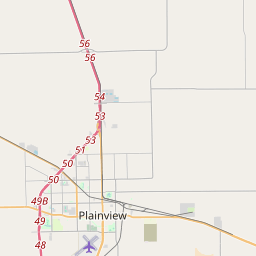Discovery Site of the Plainview Point
Historical marker location:






The first of this distinctive type of early man dart point was found by 15-year-old Val Keene Whitacre in 1941, in a caliche quarry on Running Water Draw. In 1944, quarry workers uncovered a fossil bone deposit, which was noted by scientists surveying the geology of the Plains. The next year a team of archeologists from the University of Texas, including Dr. E. H. Sellards and Dr. Alex D. Krieger, excavated the site and found 26 man-made artifacts, including several of the points, in association with the remains of about 100 extinct bison (Bison Taylori), about twice the size of modern species. The long flint point was then named for this site.
The bone bed probably resulted from the primitive hunting method of stampeding bison over a cliff, and butchering of the dead and crippled animals for food. The cliff eroded away and covered the bones with 12 to 14 feet of silt. When exposed, the bone bed was 62 feet long, up to 10 feet wide, and 1.5 feet thick. Radiocarbon dating indicates that this site is 8,000 to 9,000 years old. The Plainview point is found most commonly in the Great Plains region of North America, but has been located also in Alaska and Mexico.
1973
As one of the most visible programs of the Texas Historical Commission (THC), historical markers commemorate diverse topics in Texas history, including: the history and architecture of houses, commercial and public buildings, religious congregations, and military sites; events that changed the course of local and state history; and individuals who have made lasting contributions to the state, community organizations, and businesses.
In the late 19th century, Texas became known for its cattle drives, in which cowboys would move herds of cattle from Texas to railheads in Kansas and other northern states. The cattle drives were dangerous and difficult work, but they played a key role in the development of the American cattle industry.
The county was officially organized in 1888 and named after Lt. John C. Hale, a hero of the Battle of San Jacinto during the Texas Revolution. Agriculture played a crucial role in the early development of Hale County, with farming and ranching becoming the primary economic activities. The arrival of the railroad in the late 19th century further facilitated trade and growth in the region.
One significant event in Hale County's history was the discovery of oil in the early 20th century. Oil fields were found near the city of Plainview, leading to an economic boom and population growth. The discovery of oil allowed for the establishment of refineries and related industries, transforming Hale County into an important oil-producing area in Texas.
In recent decades, the economy of Hale County has diversified, with the advent of new industries such as healthcare, manufacturing, and education. The county continues to be a major agricultural producer, specializing in cotton, sorghum, and cattle ranching. Hale County is also known for its strong community spirit and has maintained its rural charm while embracing progress and modernization.
Hale County Timeline
This timeline provides a glimpse into the major events and milestones that have shaped the history of Hale County, Texas.
- 1876: Hale County is founded as a part of the Texas Panhandle.
- 1881: The first permanent settlement, Plainview, is established.
- 1888: The Santa Fe Railroad reaches Plainview, boosting the town's growth.
- 1891: Hale County is officially organized.
- 1892: The first courthouse is constructed in Plainview.
- 1907: The Discovery Oil Well is drilled, leading to an oil boom in the county.
- 1920: The town of Hale Center is incorporated.
- 1930s: The Great Depression hits Hale County, causing significant economic hardship.
- 1941: United States enters World War II, causing Hale County to experience an increase in agricultural production.
- 1950s: The introduction of irrigation systems revolutionizes agriculture in the county.
- 1980: Hale County experiences an economic downturn due to a decline in the oil industry.
- 1990s: The establishment of wind farms begins to diversify the county's energy sources.
- 2008: Hale County suffers from a severe drought, affecting agricultural production.
- 2010s: Renewed focus on economic development and tourism to boost the county's economy.